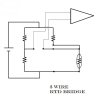Hi,
I am trying to develop a PT100 (RTD) based circuit. I have a PT100 connected in a Wheatstone bridge.
The bridge is excited with +5v supply and has
4k7-RTD and 4k7-100e resistance arms. (1% resistors)
I wish to apply a constant current source to this bridge and pass a near 1mA current through each bridge arm.
Not sure with the change in resistance of RTD(PT100) how the current can still remain constant at @ 1mA! .... Please throw some light.
Can I implement the current source using LM134/234/334?
Please share your ideas/experience about the exact circuit that I can try out.
I am trying to develop a PT100 (RTD) based circuit. I have a PT100 connected in a Wheatstone bridge.
The bridge is excited with +5v supply and has
4k7-RTD and 4k7-100e resistance arms. (1% resistors)
I wish to apply a constant current source to this bridge and pass a near 1mA current through each bridge arm.
Not sure with the change in resistance of RTD(PT100) how the current can still remain constant at @ 1mA! .... Please throw some light.
Can I implement the current source using LM134/234/334?
Please share your ideas/experience about the exact circuit that I can try out.



